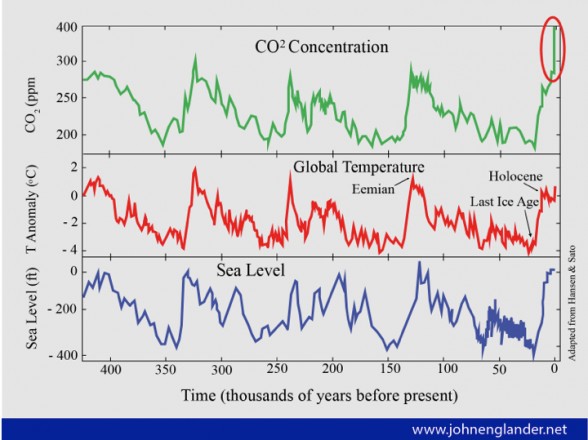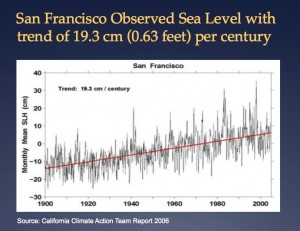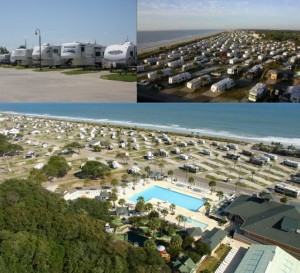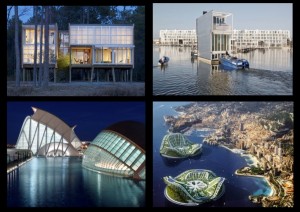The Shoreline of the Future: Permanently Temporary

Who will you meet?
Cities are innovating, companies are pivoting, and start-ups are growing. Like you, every urban practitioner has a remarkable story of insight and challenge from the past year.
Meet these peers and discuss the future of cities in the new Meeting of the Minds Executive Cohort Program. Replace boring virtual summits with facilitated, online, small-group discussions where you can make real connections with extraordinary, like-minded people.
Hundreds of millions of years ago sea level was 600 feet higher than it is today, and at the peak of the last ice age, around 20,000 years ago, sea level was almost 400 feet lower than now. “So,” climate change skeptics say, “sea level goes up. Sea level goes down. It’s a natural cycle so if sea level rises again, we’ve dealt with before so we can deal with it again.”
The skeptics are wrong on both counts. The sea level rise we’re experiencing now is not “natural,” and “we” (civilized humans) have never dealt with rising sea level.
Over the last few million years, each “natural” sea level cycle has lasted about 100,000 years. When global temperatures were at their lowest, a massive proportion of the Earth’s water supply was frozen into ice sheets, and sea level was at its lowest level. Then, as temperatures rose, the ice slowly melted into water, which flowed to the sea, and ocean level rose. During each 100,000-year cycle, the cooling period lasted about 80,000 years, followed by 20,000 years of warming.
C arbon dioxide and other greenhouse gases moderate the Earth’s temperature. Therefore, it’s not surprising that carbon dioxide levels tracked pretty closely with temperature levels and sea levels. At the coldest point, average global temperatures were about nine degrees F lower than now, sea level was 400 feet lower, and CO2 concentration was around 180 parts per million (ppm). The last cold point was about 20,000 years ago. Over the following 12,000 years, temperature and sea level climbed to where they are now, and the CO2 concentration reached about 280 ppm. This “up phase” ended about 8,000 years ago, and conditions have been pretty stable. If what we’re experiencing were part of a natural cycle, we should have slowly begun to turn the corner and enter a very long (80,000 years or so) decline in temperatures, sea level, and CO2 concentrations as we slide into the next ice age.
arbon dioxide and other greenhouse gases moderate the Earth’s temperature. Therefore, it’s not surprising that carbon dioxide levels tracked pretty closely with temperature levels and sea levels. At the coldest point, average global temperatures were about nine degrees F lower than now, sea level was 400 feet lower, and CO2 concentration was around 180 parts per million (ppm). The last cold point was about 20,000 years ago. Over the following 12,000 years, temperature and sea level climbed to where they are now, and the CO2 concentration reached about 280 ppm. This “up phase” ended about 8,000 years ago, and conditions have been pretty stable. If what we’re experiencing were part of a natural cycle, we should have slowly begun to turn the corner and enter a very long (80,000 years or so) decline in temperatures, sea level, and CO2 concentrations as we slide into the next ice age.
Here’s where things get unnatural. The Industrial Revolution, powered by the burning of fossil fuels, has increased CO2 concentrations in the atmosphere to over 400 ppm, a level that was last reached in the Pliocene Epoch when alligators lived in swamps in what is now Canada.
 So instead of getting cooler, both atmospheric and ocean temperatures have increased about 1.5 degrees F over the past hundred years. As global temperatures have risen, the water mass in the world’s oceans has expanded, glaciers have melted, and the ice sheets on Greenland and Antarctica are beginning to slide into the sea. The result has been a gradual increase in sea level of about eight inches over the past
So instead of getting cooler, both atmospheric and ocean temperatures have increased about 1.5 degrees F over the past hundred years. As global temperatures have risen, the water mass in the world’s oceans has expanded, glaciers have melted, and the ice sheets on Greenland and Antarctica are beginning to slide into the sea. The result has been a gradual increase in sea level of about eight inches over the past
century.
Without diminishing the critical importance of measures being taken to reduce greenhouse gas emissions, it’s essential to understand one simple fact: The amount of CO2 and other heat-trapping gases already in the atmosphere from past emissions is so great that decades of temperature rise and centuries of sea level rise are inevitable.
This is why we have to face the other claim that climate change skeptics make: We humans have dealt with rising sea level before so we can deal with it again.
 Modern humans have been around for about 200,000 years, during a warm spell between two ice ages. Since then there have been two more ice ages and two warm periods, including the one we are in now that’s lasted about 8,000 years thus far. About 2,000 years into this warm climate epoch human civilization evolved in Mesopotamia and Egypt. Thus, during our entire 6,000-year history as a civilized society, we humans have lived in warm stable climatic conditions. No great amount of ice was freezing or melting so, except for waves and tides, sea level wasn’t going up or down. Absent a rising sea level to overtop the edge of a coastal plain or a lower sea level to permanently expose a beach, the location of the shoreline didn’t move inland or seaward.
Modern humans have been around for about 200,000 years, during a warm spell between two ice ages. Since then there have been two more ice ages and two warm periods, including the one we are in now that’s lasted about 8,000 years thus far. About 2,000 years into this warm climate epoch human civilization evolved in Mesopotamia and Egypt. Thus, during our entire 6,000-year history as a civilized society, we humans have lived in warm stable climatic conditions. No great amount of ice was freezing or melting so, except for waves and tides, sea level wasn’t going up or down. Absent a rising sea level to overtop the edge of a coastal plain or a lower sea level to permanently expose a beach, the location of the shoreline didn’t move inland or seaward.
Therefore, as a civilized species, we have learned that the shoreline has always been where the shoreline always was. We came to believe that the shoreline will always be where it is because that’s where it’s always been. Thinking that this belief was a fact, we have developed all sorts of cultural, legal, regulatory rules and customs around the notion that location of the shoreline is a fixed line on the face of the Earth. Laws allow areas landward of the shoreline to be privately-owned and used in any manner desired by the property owner and government planning policies, while areas seaward of the shoreline are owned by the public and restricted only to uses allowed by the Public Trust Doctrine. The location of the shoreline (often expressed as some average or mean level between high and low tides) is treated as an unchanging demarcation between adjoining properties. In places where the shoreline isn’t at a fixed location due to unique legal or political circumstances, the law sometimes requires that efforts be made to create a fixed shoreline. For example, in carrying out a California state law enacted to prevent the further reclamation (i.e., filling) of shallow parts of San Francisco Bay, the state agency that implements the law is required to “establish a permanent shoreline” when it approves any additional bay filling (California Government Code Section 66605(f)).
But as sea level rises ever higher it will first overtop the current “natural” edge of the shoreline and eventually the levees, seawalls and other protective structures built to keep the sea from intruding onto the land. As the sea level rises upward, the shoreline will move inland––or at least it will unless the shoreline barriers are built ever higher, wider and stronger.
As a civilized species humans have never had to deal with the idea that sea level changes or that, left unattended, the “natural” location of the shoreline will move inland. Now, suddenly, our human experience has become irrelevant. From this point forward into the future the location of the shoreline will always be “permanently temporary.” This is a difficult concept to grasp. To deal with this challenge, we’ll have to find new ways to plan, develop, enjoy and make productive use of our immediate shoreline areas in manner that will accommodate and adapt to the fact that the shoreline wants to forever migrate inland.
As we think about this, we will quickly come to realize that building castles that we expect to last for a thousand years may not be a good idea any more. Sand sculptures built on beaches are probably the only types of castles we should build along our coastlines in the future.
 A ubiquitous travel trailer is the building typology that’s most resilient to rising sea level. A coastal resident can park her dwelling unit right on the waterfront and then, as the water level rises, simply tow it uphill.To make maximum advantage of the resilience of recreational vehicles, perhaps we should design coastal communities that operate more like long-term campgrounds than permanent cities. But do we really want all of our shoreline cities to look like RV campgrounds?
A ubiquitous travel trailer is the building typology that’s most resilient to rising sea level. A coastal resident can park her dwelling unit right on the waterfront and then, as the water level rises, simply tow it uphill.To make maximum advantage of the resilience of recreational vehicles, perhaps we should design coastal communities that operate more like long-term campgrounds than permanent cities. But do we really want all of our shoreline cities to look like RV campgrounds?
New architectural forms that can adapt to rising sea level are being developed. In some places, floating structures may make sense. In other places, buildings designed to last only a short period of time may work. Structures that can be disassembled, moved and reassembled are also worthy of consideration.
Unfortunately, some of our existing laws and regulations that were enacted when we thought the location of the shoreline never moved make it difficult, if not impossible, to authorize structures that are resilient to rising sea level. So after we figure out what resilient shoreline development looks like, we will have to reverse engineer our laws to make it possible for government agenies to permit the resilient structures.
 One prominent example of why it’s necessary to wholly rethink and probably substantially revise state law to deal with rising sea level is the McAteer-Petris Act, the California state law mentioned previously, which was enacted half a century ago to stop the wholesale unnecessary filling of San Francisco Bay. Between 1850 and 1960 about a third of the shallow bay had been diked off for salt production or agricultural use, used for garbage dumps, filled for real estate development or otherwise “reclaimed” for productive use. A study by the Army Corps of Engineers found that it was economically feasible to reclaim 70% of the ramaining bay. Alarmed by a map depicting that the bay could become little more than a wide river by 2020. Bay Area citizens formed Save San Francisco Bay Association and convinced the California legislature to establish a new state agency––the San Francisco Bay Conservation and Development Commission (BCDC). BCDC was directed to prepare a long-range plan for the bay’s management, and to regulate development in the bay and along its shoreline. When federal legislation was enacted in 1972 to encourage states to create state coastal management agencies it dawned on observers that California had created the first one seven years earlier when BCDC was established.
One prominent example of why it’s necessary to wholly rethink and probably substantially revise state law to deal with rising sea level is the McAteer-Petris Act, the California state law mentioned previously, which was enacted half a century ago to stop the wholesale unnecessary filling of San Francisco Bay. Between 1850 and 1960 about a third of the shallow bay had been diked off for salt production or agricultural use, used for garbage dumps, filled for real estate development or otherwise “reclaimed” for productive use. A study by the Army Corps of Engineers found that it was economically feasible to reclaim 70% of the ramaining bay. Alarmed by a map depicting that the bay could become little more than a wide river by 2020. Bay Area citizens formed Save San Francisco Bay Association and convinced the California legislature to establish a new state agency––the San Francisco Bay Conservation and Development Commission (BCDC). BCDC was directed to prepare a long-range plan for the bay’s management, and to regulate development in the bay and along its shoreline. When federal legislation was enacted in 1972 to encourage states to create state coastal management agencies it dawned on observers that California had created the first one seven years earlier when BCDC was established.
BCDC has generally been well regarded and has been successful in carrying out its three primary goals: (1) preventing the bay from getting ever smaller from unnecessary filling; (2) increasing public access to and along the bay shoreline; and (3) promoting high quality development along the waterfront.
Although BCDC published a pioneering report on sea level rise in 1987, the agency didn’t fully incorporate that issue into its planning until 2007 when it came to realize that the vast low-lying filled areas and reclaimed land around the shoreline of the bay made the Bay Area uniquely vulnerable to flooding from future sea level rise. This realization also made it clear that achieving the agency’s original mission of preventing the bay from getting smaller had become obsolete. The challenge the region is now facing is that rising sea level will make the bay larger. So instead of protecting the bay from the communities surrounding the bay, the communities need to be protected from a rising bay.
BCDC has a mandate to prevent the bay from being filled and authority to prevent that from happening. It has no mandate to deal with sea level rise and no authority to do anything about it. Therefore, it would have been reasonable for the agency to, in essence, declare: “Dealing with this problem isn’t our job, and we can’t do anything about the problem even if we wanted to.” Wisely and bravely, BCDC chose to not take this position. Instead, the agency embarked on a comprehensive assessment of the impacts of future flood risks from anticipated sea level rise. The 2011 publication a BCDC report entitled “Living with a Rising Bay: Vulnerability and Adaptation in San Francisco Bay and On the Shoreline” culminated an intense, raucous and effective stakeholder engagement process, which ended with a coalition of business, environmental, and local government interests supporting BCDC’s unanimous adoption of the nation’s first state coastal management agency development regulations for addressing sea level rise.
In the ensuing years BCDC has been both examining its laws, policies, and regulations to determine which, if any, will have to be refined to encourage (or at least allow) uses, facilities and development that will be resilient to rising sea level, as well as to protect the natural resources of San Francisco Bay.
It remains to be seen whether other government agencies will engage in a similar forward-looking approach or will resort to insisting on trying to deal with the Earth as it used to be instead dealing with the Earth as it’s transformed by climate change.
Discussion
Leave your comment below, or reply to others.
Please note that this comment section is for thoughtful, on-topic discussions. Admin approval is required for all comments. Your comment may be edited if it contains grammatical errors. Low effort, self-promotional, or impolite comments will be deleted.
2 Comments
Submit a Comment
Read more from MeetingoftheMinds.org
Spotlighting innovations in urban sustainability and connected technology
Middle-Mile Networks: The Middleman of Internet Connectivity
The development of public, open-access middle mile infrastructure can expand internet networks closer to unserved and underserved communities while offering equal opportunity for ISPs to link cost effectively to last mile infrastructure. This strategy would connect more Americans to high-speed internet while also driving down prices by increasing competition among local ISPs.
In addition to potentially helping narrow the digital divide, middle mile infrastructure would also provide backup options for networks if one connection pathway fails, and it would help support regional economic development by connecting businesses.
Wildfire Risk Reduction: Connecting the Dots
One of the most visceral manifestations of the combined problems of urbanization and climate change are the enormous wildfires that engulf areas of the American West. Fire behavior itself is now changing. Over 120 years of well-intentioned fire suppression have created huge reserves of fuel which, when combined with warmer temperatures and drought-dried landscapes, create unstoppable fires that spread with extreme speed, jump fire-breaks, level entire towns, take lives and destroy hundreds of thousands of acres, even in landscapes that are conditioned to employ fire as part of their reproductive cycle.
ARISE-US recently held a very successful symposium, “Wildfire Risk Reduction – Connecting the Dots” for wildfire stakeholders – insurers, US Forest Service, engineers, fire awareness NGOs and others – to discuss the issues and their possible solutions. This article sets out some of the major points to emerge.
Innovating Our Way Out of Crisis
Whether deep freezes in Texas, wildfires in California, hurricanes along the Gulf Coast, or any other calamity, our innovations today will build the reliable, resilient, equitable, and prosperous grid tomorrow. Innovation, in short, combines the dream of what’s possible with the pragmatism of what’s practical. That’s the big-idea, hard-reality approach that helped transform Texas into the world’s energy powerhouse — from oil and gas to zero-emissions wind, sun, and, soon, geothermal.
It’s time to make the production and consumption of energy faster, smarter, cleaner, more resilient, and more efficient. Business leaders, political leaders, the energy sector, and savvy citizens have the power to put investment and practices in place that support a robust energy innovation ecosystem. So, saddle up.







Love e article and I am the opposite of a Denier (is there a word for that?), but I have to disagree with you on human experience of sea level fluctuations.
You are right that the species has not experienced the extreme fluctuations you reference, but we have experienced smaller ones, including the land bridge along the Aleutian Islands that enabled migration from Asia into North America. As a Brit, I was also intrigued to learn a few ago in one of Robert MacFarlane’s wonderful books (The Old Ways, IIRC) that in the last ice age, the southern part of what is now the North Sea was exposed as land thus connecting the European continent to Britain. In the book he mentions that traces of roads and settlements can still be found on the sea bed. So my ancestors must have had to deal with rising sea levels that eventually covered their homes, although probably urban planning regulations were less formal in those days.
In fact the southern East coast of England (Essex, Suffolk, Norfolk, Lincolnshire) is still changing due to erosion, with coastal properties eventually falling into the sea. There was a study of this problem during the George Brown government (10-12 years ago) that concluded that the cost of building defensive sea walls would exceed the cost of compensating the owners of these properties and so this land is being slowly sacrificed to the sea.
One might also speculate that it was such a fluctuating land bridge that enabled the Israelites to cross the Red Sea and thus escape from Egypt.
However, all that aside, I greatly enjoyed the article. Regards, colin
I live in Florida, where Gov. Rick Scott has refused to allow any state employee from utter the phrase “global climate change.” Coastal cities such as Miami and Tampa are now dealing with a phenomena of clear weather flooding. Streets are flooded in dry weather. Storm sewers that normally drain flood water into the sea are doing the exact reverse: draining the sea into the streets. State government is completely ignoring the issue, leaving cities to fend for themselves. Gov. Scott will run against Senator Bill Nelson in 2018.
Another issue plaguing Florida is shoreline erosion and beach re-nourishment. In my area, coastal homeowners are begging for beach re-nourishment so that their homes don’t fall into the Gulf of Mexico because the shoreline has eroded so far. But construction along the coast is now increasing as older single-family homes are torn down to be replaced with multi-story condos. California may be trying to get ahead of the game, but Florida hasn’t yet gotten the memo.